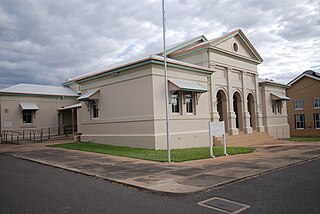
Charters Towers Courthouse is a heritage-listed courthouse at 28 Hodgkinson Street, Charters Towers City, Charters Towers, Charters Towers Region, Queensland, Australia. It was designed by John James Clark and built in 1886 by Charles Miller. It is also known as Charters Towers Courthouse. It was added to the Queensland Heritage Register on 21 October 1992.

The Bank of New South Wales is a heritage-listed former bank at 242 Mary Street, Gympie, Gympie Region, Queensland, Australia. It was designed by Richard Gailey and built from 1890 to 1891 by T. Kelly. It is also known as Widgee Shire Council Chambers, Coolooa Shire Council Chambers and Gympie Regional Council Chambers. It was added to the Queensland Heritage Register on 15 April 2011.

Crawford and Co Building is a heritage-listed commercial building at 216 Mary Street, Gympie, Gympie Region, Queensland, Australia. It was designed by Hugo Durietz and built from 1881 to 1885. It is also known as Goldsworthy Building, Caston and Davidson Building, and Sym and Jackson Building. It was added to the Queensland Heritage Register on 15 July 2011.
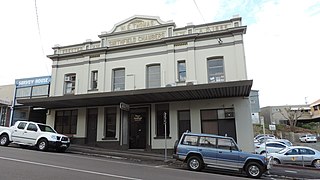
Smithfield Chambers is a heritage-listed office building at 235 Mary Street, Gympie, Gympie Region, Queensland, Australia. It was designed by Leslie Gordon Corrie and built in the 1890s by William Anthony. It was added to the Queensland Heritage Register on 15 July 2011.

Gympie Stock Exchange is a heritage-listed former bank building and former stock exchange at 236 Mary Street, Gympie, Gympie Region, Queensland, Australia. It was designed by Francis Drummond Greville Stanley and built from 1881 to 1882. It is also the former Australian Joint Stock Bank and the Neilson, Stanton and Parkinson Building. It was added to the Queensland Heritage Register on 15 April 2011.

Queensland National Bank is a heritage-listed former bank at 295–303 Flinders Street, Townsville CBD, City of Townsville, Queensland, Australia. It was designed by Francis Drummond Greville Stanley and built from 1878 to 1879 by C A Ward. It was added to the Queensland Heritage Register on 28 January 1994.

Imperial Hotel is a heritage-listed hotel at Macrossan Street, Ravenswood, Charters Towers Region, Queensland, Australia. It was designed by Eaton, Bates & Polin and built in 1901. It was added to the Queensland Heritage Register on 21 October 1992.

Ravenswood Post Office is a heritage-listed post office at Macrossan Street, Ravenswood, Charters Towers Region, Queensland, Australia. It was built in 1885 by the Queensland Public Works Department. It was added to the Queensland Heritage Register on 21 October 1992.

Thorps Building is a heritage-listed commercial building at Macrossan Street, Ravenswood, Charters Towers Region, Queensland, Australia. It was built c. 1903. It is also known as Burns & Fritz Hardware, Hollimans Limited, and Thorp's Goldfield Tearooms. It was added to the Queensland Heritage Register on 21 October 1992.

Bartlam's Store is a heritage-listed former pair of shops and now museum at Mosman Street, Charters Towers City, Charters Towers, Charters Towers Region, Queensland, Australia. It was built from c. 1891 to 1940s. It is also known as Burns Philp & Company Limited and Wright Heaton & Company. It was acquired by the National Trust in 1978, and the Zara Clark Museum was subsequently established in the building. It was added to the Queensland Heritage Register on 21 October 1992.
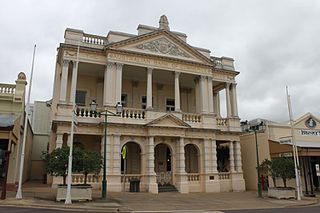
Australian Bank of Commerce is a heritage-listed former bank building at 86 Mosman Street, Charters Towers City, Charters Towers, Charters Towers Region, Queensland, Australia. It was designed by Francis Drummond Greville Stanley and built in 1891 by Wyatt & Gates. It is also known as The Australian Joint Stock Bank and is now The World Theatre. It was added to the Queensland Heritage Register on 21 October 1992.
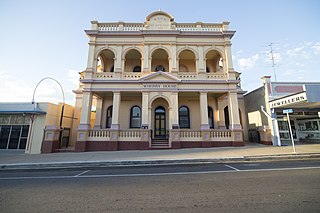
Bank of New South Wales is a heritage-listed former bank building at 34–36 Gill Street, Charters Towers City, Charters Towers, Charters Towers Region, Queensland, Australia. It was designed by Eyre & Munro and built in 1889 by Kelleher. It is also known as Wherry House. It was added to the Queensland Heritage Register on 9 November 2012.

Aldborough is a heritage-listed villa at 25 Deane Street, Charters Towers City, Charters Towers, Charters Towers Region, Queensland, Australia. It was designed by William Henry Allan Munro and built in 1900 by Thomas Barry O'Meara. It was added to the Queensland Heritage Register on 14 August 2008.

ED Miles Mining Exchange is a heritage-listed commercial building at 65 Mosman Street, Charters Towers City, Charters Towers, Charters Towers Region, Queensland, Australia. It was designed by William George Smith junior, and built in 1887 by Ben Toll. It was added to the Queensland Heritage Register on 9 November 2012.

Lyall's Jewellery Shop is a heritage-listed shop at 90 Mosman Street, Charters Towers City, Charters Towers, Charters Towers Region, Queensland, Australia. It was built in 1897. It is also known as Charters Towers & Dalrymple Historical Society Folk Museum. It was added to the Queensland Heritage Register on 21 October 1992.
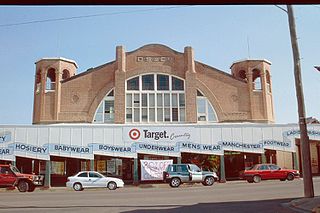
Pollard's Store is a heritage-listed department store at 18 Gill Street, Charters Towers City, Charters Towers, Charters Towers Region, Queensland, Australia. It was built from c. 1909 to 1930s. It was also known as Daking-Smith & Company and Fossey's Store. It was a Target Country store until it was converted to the K Hub format in 2021. It was added to the Queensland Heritage Register on 3 October 1996.

Croydon Shire Hall is a heritage-listed town hall at Samwell Street, Croydon, Shire of Croydon, Queensland, Australia. It was built c. 1892. It is also known as Croydon Shire Office and Croydon Town Hall. It was added to the Queensland Heritage Register on 11 June 1996.

Ambulance Building is a heritage-listed former ambulance station and now museum at 157 Gill Street, Charters Towers City, Charters Towers, Charters Towers Region, Queensland, Australia. It was designed by Walter Hunt and built in 1903 by Arthur Reid and James Walker. It is also known as Ambulance Building (former). It was added to the Queensland Heritage Register on 4 December 2015.

Charters Towers Post Office is a heritage-listed post office at 17 Gill Street, Charters Towers City, Charters Towers, Charters Towers Region, Queensland, Australia. It was added to the Australian Commonwealth Heritage List on 8 November 2011.

Queensland National Bank is a heritage-listed former bank building at 72 Mosman Street, Charters Towers City, Charters Towers, Charters Towers Region, Queensland, Australia. It was designed by Francis Drummond Greville Stanley and built from 1891 to 1949. It is also known as the Charters Towers' City Hall. It was added to the Queensland Heritage Register on 26 June 2020.
























